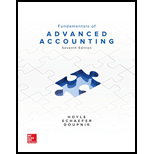
Concept explainers
a.
Prepare a post-combination
a.
Explanation of Solution
The post-combination balance sheet for Company N as of the acquisition date is as follows:
| Assets | Liabilities and owner's equity | ||
| Cash | $ 64,000 | Accounts payable | $ 144,000 |
| Receivables | $ 213,000 | Notes payable | $ 415,000 |
| Trademarks | $ 625,000 | Common stock | $ 460,000 |
| Record music catalog | $ 1,020,000 | Additional paid-in capital | $ 695,000 |
| Research and development asset | $ 200,000 | $ 860,000 | |
| Equipment (net) | $ 425,000 | ||
| $ 27,000 | |||
| Totals | $ 2,574,000 | Totals | $ 2,574,000 |
Table: (1)
Working note:
| General Journal | ||||
| Date | Account Title and Explanation | Post Ref. | Debit ($) | Credit ($) |
| i) | Receivables | $ 63,000 | ||
| Trademarks | $ 225,000 | |||
| Record music catalog | $ 180,000 | |||
| In-process research and development | $ 200,000 | |||
| Cash | $ 29,000 | |||
| Equipment | $ 105,000 | |||
| Goodwill | $ 27,000 | |||
| Accounts payable | $ 34,000 | |||
| Notes payable | $ 45,000 | |||
| Common stock | $ 60,000 | |||
| Additional paid-in capital | $ 690,0000 | |||
| (to record the assets and liabilities acquired) | ||||
| ii) | Stock issuance cost | $ 25,000 | ||
| Cash | $ 25,000 | |||
| (being Stock issuance cost paid) | ||||
Table: (2)
Computation of the fair value of the consideration transferred:
Thus, the fair value of the consideration transferred in this combination is $750,000.
b.
Prepare a worksheet to consolidate the two companies as of the combination date.
b.
Explanation of Solution
The worksheet to consolidate the two companies as of the combination date is as follows:
| Particulars | Company N | Company O | Consolidated Entries | Consolidated Balances | ||
| Cash | $ 35,000 | $ 29,000 | $ 64,000 | |||
| Receivables | $ 150,000 | $ 65,000 | $ 2,000 | $ 213,000 | ||
| Investment of Company O | $ 750,000 | $ - | $ 270,000 | |||
| $ 480,000 | $ - | |||||
| Trademarks | $ 400,000 | $ 95,000 | $ 130,000 | $ 625,000 | ||
| Record music catalog | $ 840,000 | $ 60,000 | $ 120,000 | $ 1,020,000 | ||
| Research and development asset | $ - | $ - | $ 200,000 | $ 200,000 | ||
| Equipment (net) | $ 320,000 | $ 105,000 | $ 425,000 | |||
| Goodwill | $ - | $ - | $ 27,000 | $ 27,000 | ||
| Totals | $ 2,495,000 | $ 354,000 | $ 2,574,000 | |||
| Accounts payable | $ (110,000) | $ (34,000) | $ (144,000) | |||
| Notes payable | $ (370,000) | $ (50,000) | $ 5,000 | $ (415,000) | ||
| Common stock | $ (460,000) | $ (50,000) | $ 50,000 | $ (460,000) | ||
| Additional paid-in capital | $ (695,000) | $ (30,000) | $ 30,000 | $ (695,000) | ||
| Retained earnings | $ (860,000) | $ (190,000) | $ 190,000 | $ (860,000) | ||
| Totals | $ (2,495,000) | $ (354,000) | $ 752,000 | $ 752,000 | $ (2,574,000) | |
Table: (3)
c.
Explain the way in which the balance sheet accounts compare across parts (a) and (b).
c.
Explanation of Solution
The balance sheet across parts (a) and (b) are however similar and only the presentation differs.
Part (a) represents the combined balances only while part (b) represents separate balances as well.
Want to see more full solutions like this?
Chapter 2 Solutions
Fundamentals of Advanced Accounting
- Please explain how to solve this financial accounting question with valid financial principles.arrow_forwardPlease show me the correct way to solve this financial accounting problem with accurate methods.arrow_forwardGibson Manufacturing budgets sales of $3,750,000, fixed costs of $145,800, and variable costs of $975,000. What is the contribution margin ratio for Gibson Manufacturing? Need answerarrow_forward
- TOSHIBA ended the year with an inventory of $842,000. During the year, the firm purchased $5,467,000 of new inventory and the cost of goods sold reported on the income statement was $5,215,000. What was TOSHIBA's inventory at the beginning of the year?arrow_forwardCan you demonstrate the proper approach for solving this financial accounting question with valid techniques?arrow_forwardCalculate the depreciation expensearrow_forward

 AccountingAccountingISBN:9781337272094Author:WARREN, Carl S., Reeve, James M., Duchac, Jonathan E.Publisher:Cengage Learning,
AccountingAccountingISBN:9781337272094Author:WARREN, Carl S., Reeve, James M., Duchac, Jonathan E.Publisher:Cengage Learning, Accounting Information SystemsAccountingISBN:9781337619202Author:Hall, James A.Publisher:Cengage Learning,
Accounting Information SystemsAccountingISBN:9781337619202Author:Hall, James A.Publisher:Cengage Learning, Horngren's Cost Accounting: A Managerial Emphasis...AccountingISBN:9780134475585Author:Srikant M. Datar, Madhav V. RajanPublisher:PEARSON
Horngren's Cost Accounting: A Managerial Emphasis...AccountingISBN:9780134475585Author:Srikant M. Datar, Madhav V. RajanPublisher:PEARSON Intermediate AccountingAccountingISBN:9781259722660Author:J. David Spiceland, Mark W. Nelson, Wayne M ThomasPublisher:McGraw-Hill Education
Intermediate AccountingAccountingISBN:9781259722660Author:J. David Spiceland, Mark W. Nelson, Wayne M ThomasPublisher:McGraw-Hill Education Financial and Managerial AccountingAccountingISBN:9781259726705Author:John J Wild, Ken W. Shaw, Barbara Chiappetta Fundamental Accounting PrinciplesPublisher:McGraw-Hill Education
Financial and Managerial AccountingAccountingISBN:9781259726705Author:John J Wild, Ken W. Shaw, Barbara Chiappetta Fundamental Accounting PrinciplesPublisher:McGraw-Hill Education





